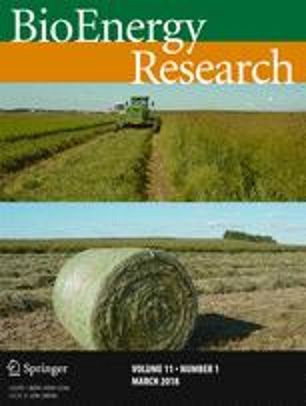Ver ítem
- xmlui.general.dspace_homeCentros e Institutos de InvestigaciónCIRN. Centro de Investigaciones de Recursos NaturalesInstituto de SuelosArtículos científicosxmlui.ArtifactBrowser.ItemViewer.trail
- Inicio
- Centros e Institutos de Investigación
- CIRN. Centro de Investigaciones de Recursos Naturales
- Instituto de Suelos
- Artículos científicos
- Ver ítem
Paenibacillus sp. A59 GH10 and GH11 extracellular endoxylanases: application in biomass bioconversion
Resumen
The cost-efficient degradation of xylan to fermentable sugars is of particular interest in second generation bioethanol production, feed, food, and pulp and paper industries. Multiple potentially secreted enzymes involved in polysaccharide deconstruction are encoded in the genome of Paenibacillus sp. A59, a xylanolytic soil bacterium, such as three endoxylanases, seven GH43 β-xylosidases, and two GH30 glucuronoxylanases. In secretome analysis of xylan
[ver mas...]
The cost-efficient degradation of xylan to fermentable sugars is of particular interest in second generation bioethanol production, feed, food, and pulp and paper industries. Multiple potentially secreted enzymes involved in polysaccharide deconstruction are encoded in the genome of Paenibacillus sp. A59, a xylanolytic soil bacterium, such as three endoxylanases, seven GH43 β-xylosidases, and two GH30 glucuronoxylanases. In secretome analysis of xylan cultures, ten glycoside hydrolases were identified, including the three predicted endoxylanases, confirming their active role. The two uni-modular xylanases, a 32-KDa GH10 and a 20-KDa GH11, were recombinantly expressed and their activity on xylan was confirmed (106 and 85 IU/mg, respectively), with differences in their activity pattern. Both endoxylanases released mainly xylobiose (X2) and xylotriose (X3) from xylan and pre-treated biomasses (wheat straw, barley straw, and sweet corn cob), although only rGH10XynA released xylose (X1). rGH10XynA presented optimal conditions at pH 6, with thermal stability at 45–50 °C, while rGH11XynB showed activity in a wider range of pH, from 5 to 9, and was thermostable only at 45 °C. Moreover, GH11XynB presented sigmoidal kinetics on xylan, indicating possible cooperative binding, which was further supported by the structural model. This study provides a detailed analysis of the complete set of carbohydrate-active enzymes encoded in Paenibacillus sp. A59 genome and those effectively implicated in hemicellulose hydrolysis, contributing to understanding the mechanisms necessary for the bioconversion of this polysaccharide. Moreover, the two main free secreted xylanases, rGH10XynA and rGH11XynB, were fully characterized, supporting their potential application in industrial bioprocesses on lignocellulosic biomass.
[Cerrar]

Autor
Fuente
BioEnergy research 11 (1) : 174–190. (March 2018)
Fecha
2018-03
Editorial
Springer
ISSN
1939-1234
Formato
pdf
Tipo de documento
artículo
Palabras Claves
Derechos de acceso
Restringido
 Excepto donde se diga explicitamente, este item se publica bajo la siguiente descripción: Creative Commons Attribution-NonCommercial-ShareAlike 2.5 Unported (CC BY-NC-SA 2.5)
Excepto donde se diga explicitamente, este item se publica bajo la siguiente descripción: Creative Commons Attribution-NonCommercial-ShareAlike 2.5 Unported (CC BY-NC-SA 2.5)

